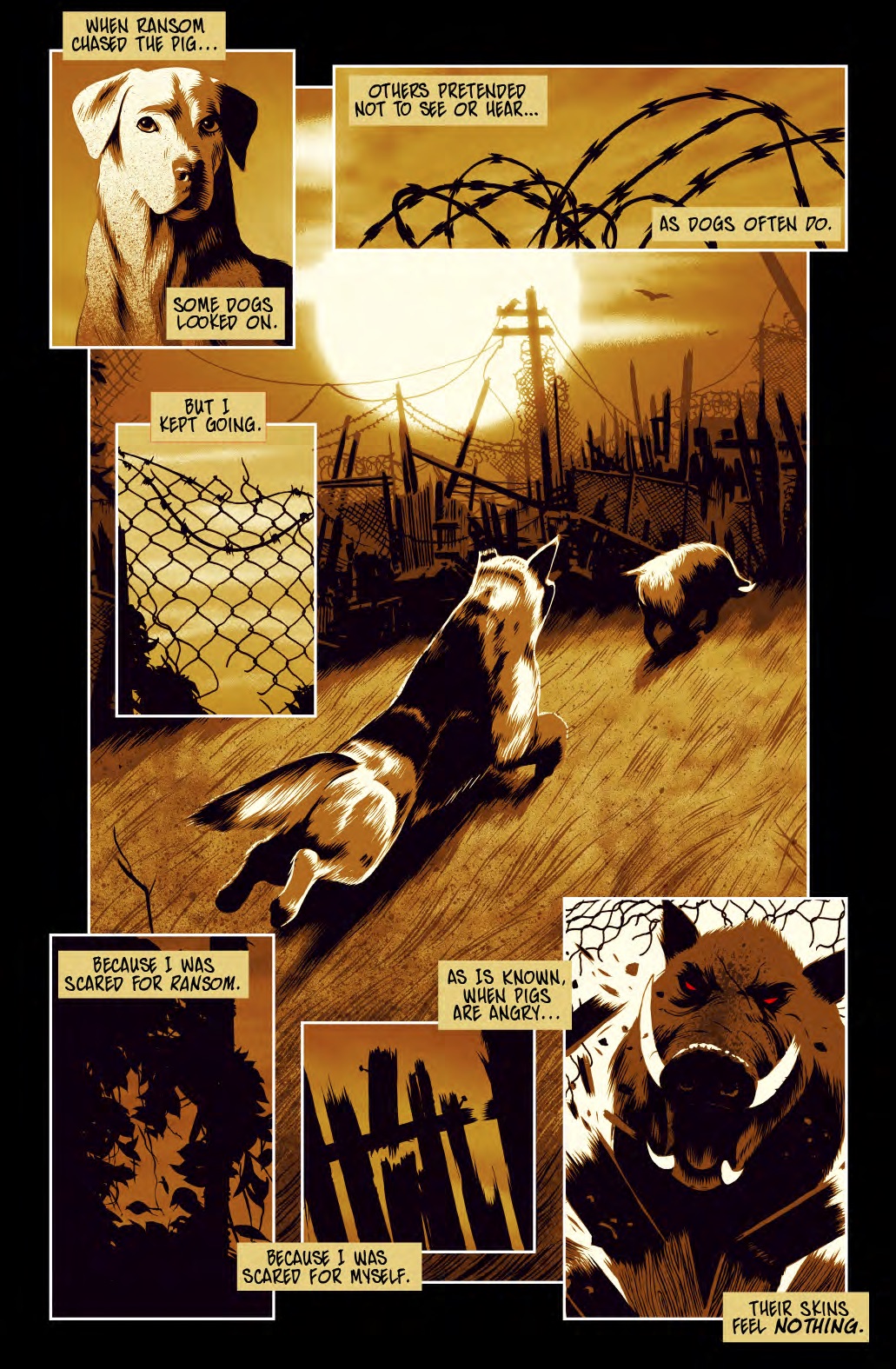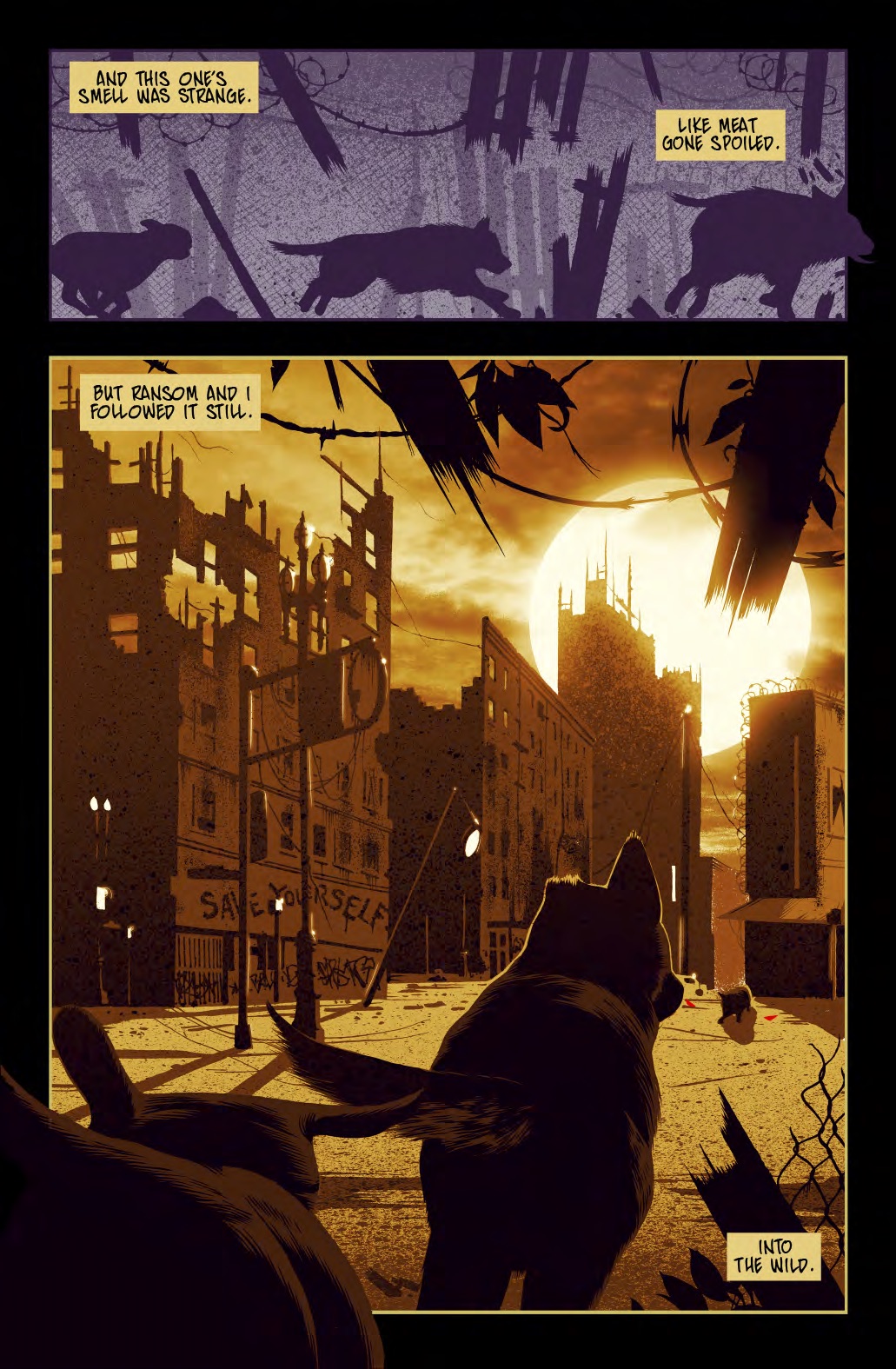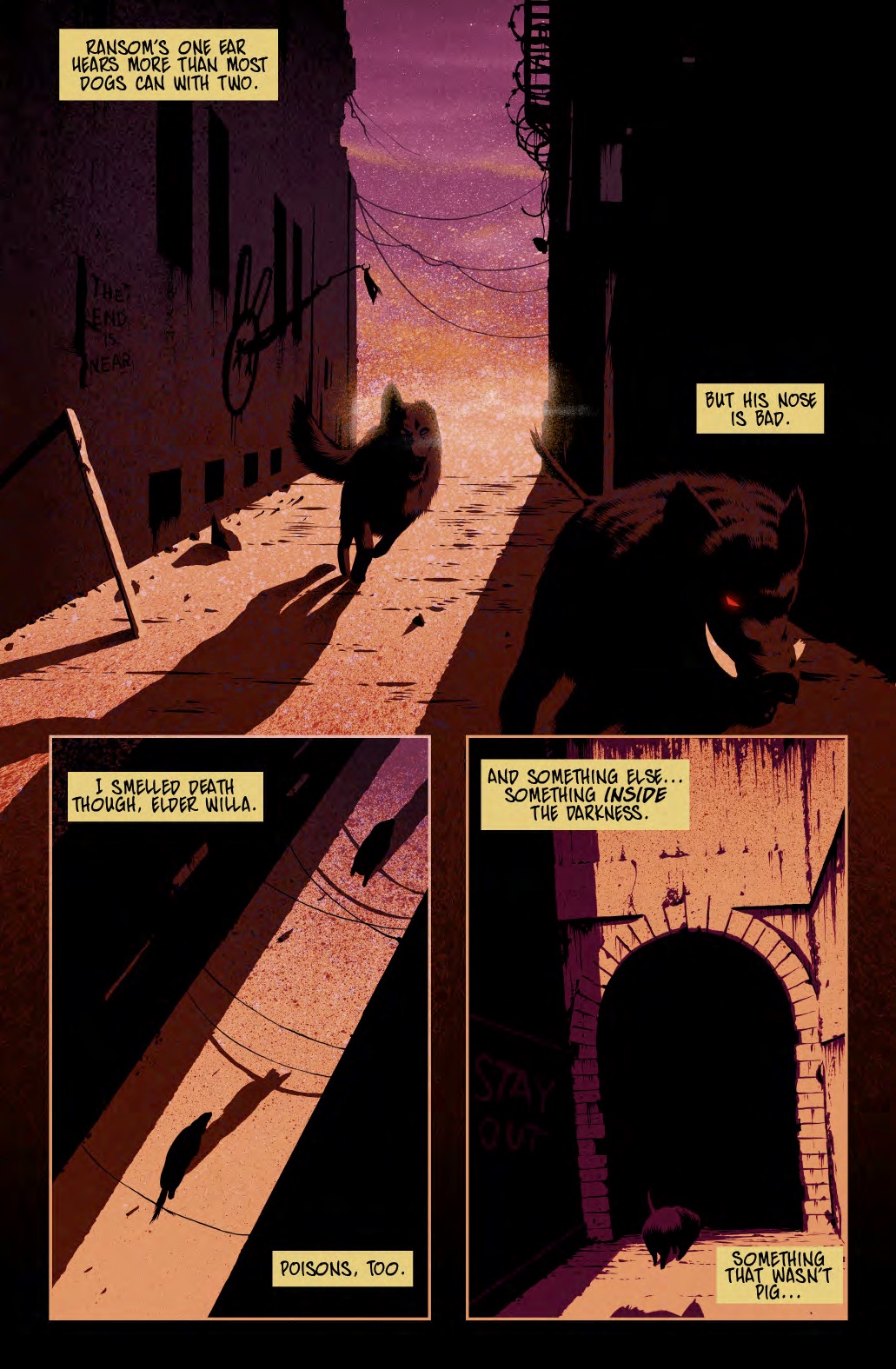Danny stands at a destroyed bar, surrounded by several unconscious, most likely dead guys. Still looking for his friend Teddy. Davis and Reynolds are back in corporate for a contract renewal after their house shows tour. The jobber is sure he’s getting the axe, and the veteran knows at this point that it’s going to be more of the same or nothing at all. And he has no choice in the matter.
 Ringside #5 goes out the way it came in, dark, gritty, and with the love/hate relationship most of the wrestling fans have towards the craft and the business behind it. The issue begins with a young Danny being taken to his first show, and it puts in context how much we love kayfabe (the story the wrestlers are telling inside the ring). As much as sometimes we criticize it, we love the maneuvers they make, we want to cheer the good guys and boo the bad ones. Then there’s the backstage politics and the fact that it’s still a business being made more so for pure passion than anything else. Danny, long separated from wrestling, seems to have taken a persona of the babyface who must face all odds (loses) and helps his childhood friend.
Ringside #5 goes out the way it came in, dark, gritty, and with the love/hate relationship most of the wrestling fans have towards the craft and the business behind it. The issue begins with a young Danny being taken to his first show, and it puts in context how much we love kayfabe (the story the wrestlers are telling inside the ring). As much as sometimes we criticize it, we love the maneuvers they make, we want to cheer the good guys and boo the bad ones. Then there’s the backstage politics and the fact that it’s still a business being made more so for pure passion than anything else. Danny, long separated from wrestling, seems to have taken a persona of the babyface who must face all odds (loses) and helps his childhood friend.
Nick Barber injects this comic with feeling exactly where it needs it. A perfectly executed German suplex double splash page? You got it. Just like Danny, it had me saying “whoa.” Davis’ reactions to his contract signing hits on a big element of wrestling and what is means to “go out on your back.” All of this accentuated by Simon Gough’s colors, which have been consistently great throughout these five issues.
This creative team bring the end of the first arc of Ringside the way a heel would pin over the face for the three count. It’s a great story, and not always the good guy wins. Me being raised in Mexico, I’m a hardcore Lucha Libre man and this is a two out of three falls match. And I can’t wait what Ringside has in store for us in July.
[button btn_url="" btn_color="primary" btn_size="large" btn_style="default" btn_outlined="no" link_target="self" link_rel="" icon_left="Score: 5/5" icon_right="Score: 5/5"]Score: 5/5[/button]
Ringside #5 Writer: Joe Keatinge Artist: Nick Barber Colorist: Simon Gough Publisher: Image Comics Price: $3.99 Release Date: 3/23/16 Format: Ongoing; Print/Digital

 The sheer amount of exposition in Snowfall #2 is enough to make you groan every time the world or the devices need to be explained halfway into the comic. Joe Harris isn’t just explaining the happenings in this comic, but justifying it. The dialogue is riddled with a lot of in-world terminology and it assumes the reader is submerged into the story having only read one issue. If there was little characterization in the first issue, it it’s done completely away with it on issue #2. Inspector Deal is described as the type of person she is, but no action backs it up, not that she has opportunity to do so. She goes from an evil council audience to mind control in a heartbeat. There is still nothing that makes Anthony a likable protagonist, he seeks answers to even more questions given to the reader as the last set of answers are rushed in one issue rather than taking its time. Dr. Reasons (these are not great names) is just an asshole. No motivation has been explained for him as of yet, and no reasons behind his past actions, or why he’s even torturing Anthony.
The sheer amount of exposition in Snowfall #2 is enough to make you groan every time the world or the devices need to be explained halfway into the comic. Joe Harris isn’t just explaining the happenings in this comic, but justifying it. The dialogue is riddled with a lot of in-world terminology and it assumes the reader is submerged into the story having only read one issue. If there was little characterization in the first issue, it it’s done completely away with it on issue #2. Inspector Deal is described as the type of person she is, but no action backs it up, not that she has opportunity to do so. She goes from an evil council audience to mind control in a heartbeat. There is still nothing that makes Anthony a likable protagonist, he seeks answers to even more questions given to the reader as the last set of answers are rushed in one issue rather than taking its time. Dr. Reasons (these are not great names) is just an asshole. No motivation has been explained for him as of yet, and no reasons behind his past actions, or why he’s even torturing Anthony. Apparently set in the year 2143, its story takes place in a world beset by something called simply “The Corruption.” This, according to
Apparently set in the year 2143, its story takes place in a world beset by something called simply “The Corruption.” This, according to  As a writer, Quade is simple and unaffected, instilling in both his leads (and those around them in issue #2) an easy rural charm. He favors the spaces between words over too complex a dialogue, and in general keeps things relatively tight and very simple. His art, however, speaks volumes. His figure work has an almost all-ages feel to it -- thick lines that scratch out exaggerated, overly-large features -- but at the same time, giving off an atmosphere that is both gritty and grim in the style of a Western revival. This is especially true once the chimera make their appearances over the two issues: horrific, bloody and mutated things, conjured from a wood-cutting of some forgotten old west grimoire. It’s fantastic and grotesque and beautiful.
As a writer, Quade is simple and unaffected, instilling in both his leads (and those around them in issue #2) an easy rural charm. He favors the spaces between words over too complex a dialogue, and in general keeps things relatively tight and very simple. His art, however, speaks volumes. His figure work has an almost all-ages feel to it -- thick lines that scratch out exaggerated, overly-large features -- but at the same time, giving off an atmosphere that is both gritty and grim in the style of a Western revival. This is especially true once the chimera make their appearances over the two issues: horrific, bloody and mutated things, conjured from a wood-cutting of some forgotten old west grimoire. It’s fantastic and grotesque and beautiful.



 The thing that continued to jump at me throughout this issue was Brian Joines control of character and their voices. Each one of them bizarre and unique, defined by their own mannerisms, and still giving life to the story and moving it along. Rather than existing in their own strange bubble saying the crazy things they do, they aport to the group and complement each other as a team. They receive more definition, as they’re sent to they’re all sent to the Hell Rooms and each one is individually marked by their history and uses their tragedies and strengths against them. Bill and Ted are dumped into a room together, where Joines is able to make fun of our own time line and hit thee Wyld Stallyns with their biggest fear.
The thing that continued to jump at me throughout this issue was Brian Joines control of character and their voices. Each one of them bizarre and unique, defined by their own mannerisms, and still giving life to the story and moving it along. Rather than existing in their own strange bubble saying the crazy things they do, they aport to the group and complement each other as a team. They receive more definition, as they’re sent to they’re all sent to the Hell Rooms and each one is individually marked by their history and uses their tragedies and strengths against them. Bill and Ted are dumped into a room together, where Joines is able to make fun of our own time line and hit thee Wyld Stallyns with their biggest fear. The action in this issue unfolds in a fairly predictable way. Most of the action takes place within the submarine as the investigation team is introduced. The confinement in this book resulted in a lack of action. I don’t mind confinement when the characters are written strongly, but they all seemed to come and go without much purpose and their dialogue is filled with cheesy one liners. It felt like you could take any random set of characters and put them in the same scenario. What makes this story predictable is that we know going in that there’s another alien threat even though the characters don’t yet. The problem is that the buildup is poorly executed. The threat is introduced in the final pages which made me feel like the book was ending when it had finally started.
The action in this issue unfolds in a fairly predictable way. Most of the action takes place within the submarine as the investigation team is introduced. The confinement in this book resulted in a lack of action. I don’t mind confinement when the characters are written strongly, but they all seemed to come and go without much purpose and their dialogue is filled with cheesy one liners. It felt like you could take any random set of characters and put them in the same scenario. What makes this story predictable is that we know going in that there’s another alien threat even though the characters don’t yet. The problem is that the buildup is poorly executed. The threat is introduced in the final pages which made me feel like the book was ending when it had finally started. At any rate, with the story we pick up after Doc’s death. The elder penguins are looking to kill Amaru and stop the prophecy. Thankfully Zolin stops by just in time and saves him. They reunite back at the Possum base and they hash things out and rebuild their friendship. We also learn how Zolin lost his eye which is pretty funny.
At any rate, with the story we pick up after Doc’s death. The elder penguins are looking to kill Amaru and stop the prophecy. Thankfully Zolin stops by just in time and saves him. They reunite back at the Possum base and they hash things out and rebuild their friendship. We also learn how Zolin lost his eye which is pretty funny. Cliff Secord has finally been reunited with his Rocketeer getup, already overseas as a volunteer in the army he is now ready to fight the Axis head on. No longer is he just a grunt soldier on the frontlines but The Rocketeer! In theory this idea has a lot of potential, and in the right hands perhaps it could have been something amazing. After all, World War II is fertile soil for a pulp comic. Writer Marc Guggenheim has given us all of the essential elements: 1940s timeframe, charismatic hero, nazis building secret weapons… All of the tropes are here, and yet they just don’t fit together like they should. Part of the downfall of this comic for me was the dialogue. Guggenheim gives Peter Parker a run for his money on Secord’s one-liners, and it’s worse that he’s so cheery while gunning people down. Killing nazis has always been a part of pulp war stories, so it’s not necessarily out of place, but for some reason it put me at odds. This issue felt like a watered down version of the original, because it is. Reboot, revival, whatever you want to call it, it’s just not the same. And I can understand the argument “it’s not supposed to be the same”, but it is, at least in a way. There’s nothing different about the characters or the plot, it’s just a different story, so why not just try to make it a little bit more like the original and not run the risk of leaving a bad taste in readers’ mouths.
Cliff Secord has finally been reunited with his Rocketeer getup, already overseas as a volunteer in the army he is now ready to fight the Axis head on. No longer is he just a grunt soldier on the frontlines but The Rocketeer! In theory this idea has a lot of potential, and in the right hands perhaps it could have been something amazing. After all, World War II is fertile soil for a pulp comic. Writer Marc Guggenheim has given us all of the essential elements: 1940s timeframe, charismatic hero, nazis building secret weapons… All of the tropes are here, and yet they just don’t fit together like they should. Part of the downfall of this comic for me was the dialogue. Guggenheim gives Peter Parker a run for his money on Secord’s one-liners, and it’s worse that he’s so cheery while gunning people down. Killing nazis has always been a part of pulp war stories, so it’s not necessarily out of place, but for some reason it put me at odds. This issue felt like a watered down version of the original, because it is. Reboot, revival, whatever you want to call it, it’s just not the same. And I can understand the argument “it’s not supposed to be the same”, but it is, at least in a way. There’s nothing different about the characters or the plot, it’s just a different story, so why not just try to make it a little bit more like the original and not run the risk of leaving a bad taste in readers’ mouths. It’s clear early on in this story that there’s no humans. They’ve either been wiped out by the robots or are just dead. It makes the story interesting because these worker robots chose human things to do. One takes up golf, but has an encounter that prevents it from really taking a swing at the sport. Another takes up art and has a very modern approach to it. All of them do things that basically robots have no business doing and really it works quite well because the point of the story isn’t that they’re robots, but that we are.
It’s clear early on in this story that there’s no humans. They’ve either been wiped out by the robots or are just dead. It makes the story interesting because these worker robots chose human things to do. One takes up golf, but has an encounter that prevents it from really taking a swing at the sport. Another takes up art and has a very modern approach to it. All of them do things that basically robots have no business doing and really it works quite well because the point of the story isn’t that they’re robots, but that we are. The title page on this one was so important (whether it represents a real death or not) and so gorgeous that the editorial team actually made the decision to leave Kubo's original lettering. Granted, given the length of the chapter's title, I think it might have at least partially been a forced choice; still, it was an editorial decision nonetheless, and it's a page I'm grateful to experience nearly exactly as Kubo intended. To end the chapter on the couple of big ink wipes that make up most of my favorite character, Kenpachi, is just too good.
The title page on this one was so important (whether it represents a real death or not) and so gorgeous that the editorial team actually made the decision to leave Kubo's original lettering. Granted, given the length of the chapter's title, I think it might have at least partially been a forced choice; still, it was an editorial decision nonetheless, and it's a page I'm grateful to experience nearly exactly as Kubo intended. To end the chapter on the couple of big ink wipes that make up most of my favorite character, Kenpachi, is just too good. It is an ugly, nerve-bending book, dealing in unsubtle imagery. Some of the panels are worth staring at for minutes just to take in the details. The busy, jumbled line work forces the eye to wander across each page. Ian Bertram's compositions are thankfully very traditionally attractive even if they are being used to portray gross and generally unpleasant scenes. One panel has a beleaguered servant dwarfed by huge and bizarre statues, riding to his seemingly never-ending work. And the following panel features a similar scene of the clearly unstable Sarah Winchester looming over an array of confiscated bullets, each round standing in place like a macabre chess piece. Again, it isn't subtle, but it works so well you're eyes are just busy enjoying it. Characters are all swollen, stretched, or otherwise malformed features rendered in anxious lines. Everyone here is a monster. As a result, no one is likable or relatable. Not yet, anyway.
It is an ugly, nerve-bending book, dealing in unsubtle imagery. Some of the panels are worth staring at for minutes just to take in the details. The busy, jumbled line work forces the eye to wander across each page. Ian Bertram's compositions are thankfully very traditionally attractive even if they are being used to portray gross and generally unpleasant scenes. One panel has a beleaguered servant dwarfed by huge and bizarre statues, riding to his seemingly never-ending work. And the following panel features a similar scene of the clearly unstable Sarah Winchester looming over an array of confiscated bullets, each round standing in place like a macabre chess piece. Again, it isn't subtle, but it works so well you're eyes are just busy enjoying it. Characters are all swollen, stretched, or otherwise malformed features rendered in anxious lines. Everyone here is a monster. As a result, no one is likable or relatable. Not yet, anyway. I’m going to save you some time and just let you know that they fix time. Why did I tell you that? Because it’s going to help me illustrate the point that there’s no consequences to this story. There’s never any doubt that they’ll fix time and so there’s no reason not to tell you that they fix it. The point of the story is just to have the characters show up and do their gimmick, but their gimmick’s aren’t strong enough because we don’t spend any real time with them.
I’m going to save you some time and just let you know that they fix time. Why did I tell you that? Because it’s going to help me illustrate the point that there’s no consequences to this story. There’s never any doubt that they’ll fix time and so there’s no reason not to tell you that they fix it. The point of the story is just to have the characters show up and do their gimmick, but their gimmick’s aren’t strong enough because we don’t spend any real time with them. One series that hasn't been in the Progs since I first started reviewing them is Aquila which makes what I would count as a triumphant return. Rennie's sense of humor and comedic timing carries over to this script as Aquila watches a gladiator match unfold and gives some betting advice. Paul Davidson's bold lines come together to form some very fun character designs, despite the fact that those characters, you know, mostly die in a gladiator match. Aquila is at its best when it mixes reality and myth, and it's easy to get a feel for both when the creative team delivers such an attractive approximation of a secutor and his armor. One of my favorite colorists in the Progs, Len O'Grady, does a stellar job of standing up to Davdison's inks and, more importantly, in giving us effectively bloody finishes.
One series that hasn't been in the Progs since I first started reviewing them is Aquila which makes what I would count as a triumphant return. Rennie's sense of humor and comedic timing carries over to this script as Aquila watches a gladiator match unfold and gives some betting advice. Paul Davidson's bold lines come together to form some very fun character designs, despite the fact that those characters, you know, mostly die in a gladiator match. Aquila is at its best when it mixes reality and myth, and it's easy to get a feel for both when the creative team delivers such an attractive approximation of a secutor and his armor. One of my favorite colorists in the Progs, Len O'Grady, does a stellar job of standing up to Davdison's inks and, more importantly, in giving us effectively bloody finishes. The writing is simple. There’s a ton and I mean a ton of exposition. I don’t think Joshua says more than a few things that aren’t exposition and that includes his narration and dialogue. The characters are pretty one dimensional at the moment. They’re character types more than anything and we’ll see if they can be anything more than that.
The writing is simple. There’s a ton and I mean a ton of exposition. I don’t think Joshua says more than a few things that aren’t exposition and that includes his narration and dialogue. The characters are pretty one dimensional at the moment. They’re character types more than anything and we’ll see if they can be anything more than that. Rosalind is your typical precocious young woman, above the grime of her surroundings. Set apart from others by her look and demeanor. She dresses wildly inappropriately for her expected gender role. In fact, she looks like an Assassin's Creed side character. This is actually quite appropriate given her special origin, an origin full of intrigue and betrayal, drama, tentacles, and tragedy. She seems very fond of her sword, as well. The books final moments indicate she's need it.
Rosalind is your typical precocious young woman, above the grime of her surroundings. Set apart from others by her look and demeanor. She dresses wildly inappropriately for her expected gender role. In fact, she looks like an Assassin's Creed side character. This is actually quite appropriate given her special origin, an origin full of intrigue and betrayal, drama, tentacles, and tragedy. She seems very fond of her sword, as well. The books final moments indicate she's need it. The pacing that emerges from putting these things together is often perfectly fine, but sometimes frustrating. One thing I really enjoy is the way that things slow down for the reader during the Red Place sections, while also hardly feeling like a break because of how mysterious and full of oddities The Red Place scenes are. Another success of the very deliberate pace of this series is the way that the creative team earns its spreads. As it has been since issue one, Kelly doesn't fuck around when he gets a chance to devote a whole page to some type of odd beast. The Wilson-assisted spread alluded to by the cover is just one outstanding page in this issue.
The pacing that emerges from putting these things together is often perfectly fine, but sometimes frustrating. One thing I really enjoy is the way that things slow down for the reader during the Red Place sections, while also hardly feeling like a break because of how mysterious and full of oddities The Red Place scenes are. Another success of the very deliberate pace of this series is the way that the creative team earns its spreads. As it has been since issue one, Kelly doesn't fuck around when he gets a chance to devote a whole page to some type of odd beast. The Wilson-assisted spread alluded to by the cover is just one outstanding page in this issue. Beyond The Fences #2 takes place during Hellboy’s second year as a B.P.R.D. agent. Written by Mignola himself (with help from Chris Roberson) and drawn beautifully by Paolo and Joe Rivera, it’s a fun but dark story of missing children, murder, and mystery, all taken place in an idyllic suburban California town in 1953. Mignola’s writing shines and Hellboy’s pulpy roots are exposed as we explore the secrets that this quaint town is hiding. At the end of issue #1 Hellboy and two B.P.R.D. agents, Stegner (an ex-military grunt) and Xiang (ex-FBI who has some psychic abilities) found themselves facing off against the creature that is thought to be responsible for the missing children. Instead of finding themselves face to face with the Jersey Devil they instead find that it is just a mutated dog, though the mutation has caused it to become huge and violent. Anyways… guns blaze, Hellboy punches, and the creature runs off, for now.
Beyond The Fences #2 takes place during Hellboy’s second year as a B.P.R.D. agent. Written by Mignola himself (with help from Chris Roberson) and drawn beautifully by Paolo and Joe Rivera, it’s a fun but dark story of missing children, murder, and mystery, all taken place in an idyllic suburban California town in 1953. Mignola’s writing shines and Hellboy’s pulpy roots are exposed as we explore the secrets that this quaint town is hiding. At the end of issue #1 Hellboy and two B.P.R.D. agents, Stegner (an ex-military grunt) and Xiang (ex-FBI who has some psychic abilities) found themselves facing off against the creature that is thought to be responsible for the missing children. Instead of finding themselves face to face with the Jersey Devil they instead find that it is just a mutated dog, though the mutation has caused it to become huge and violent. Anyways… guns blaze, Hellboy punches, and the creature runs off, for now. A quick read of the back of the issue tells me that she’s joining a military organization, but the actual issue never tells us that. The story itself isn’t bad, but it does distract you with action and drama to prevent you from asking important questions. Such as, why two kids were able to sneak into a military camp, why is there a military camp within walking distance of their town? What’s going on in this world in general that has two groups fighting? Why did they only care that they got the one kid and not the other that they saw two? There’s a lot of what I feel are obvious questions completely ignore by the story.
A quick read of the back of the issue tells me that she’s joining a military organization, but the actual issue never tells us that. The story itself isn’t bad, but it does distract you with action and drama to prevent you from asking important questions. Such as, why two kids were able to sneak into a military camp, why is there a military camp within walking distance of their town? What’s going on in this world in general that has two groups fighting? Why did they only care that they got the one kid and not the other that they saw two? There’s a lot of what I feel are obvious questions completely ignore by the story. Similarly, the layouts which, despite an undeniable beauty, are sometimes creative at the cost of being readable. While the issue mostly works in the same elegant fashion as the first, there are a couple of points where I was yanked out of the story by an inability to tell precisely what I was looking at (always a risk in sequences which involved magical powers to begin with). One battle sequence is laid out almost like a stained glass, with onlookers looking at three giant images of magical animals battling soldiers. It's a beautiful moment to be sure, but a more traditional battle scene likely would have been a better storytelling tool.
Similarly, the layouts which, despite an undeniable beauty, are sometimes creative at the cost of being readable. While the issue mostly works in the same elegant fashion as the first, there are a couple of points where I was yanked out of the story by an inability to tell precisely what I was looking at (always a risk in sequences which involved magical powers to begin with). One battle sequence is laid out almost like a stained glass, with onlookers looking at three giant images of magical animals battling soldiers. It's a beautiful moment to be sure, but a more traditional battle scene likely would have been a better storytelling tool. On the flip side, there’s a story about Mr. Teacher fucking up some cars in a parking lot trying to sell car insurance. Gotta love this guy because he thinks that will actually work. He gives a fake name and ends up getting a real person at the job fired. This story of the fired man’s shitty life continues through two more stories, but Mr. Teacher and Panda proceed to do different things that inadvertently screw this man’s life over. I actually liked this tale and its continuation a lot.
On the flip side, there’s a story about Mr. Teacher fucking up some cars in a parking lot trying to sell car insurance. Gotta love this guy because he thinks that will actually work. He gives a fake name and ends up getting a real person at the job fired. This story of the fired man’s shitty life continues through two more stories, but Mr. Teacher and Panda proceed to do different things that inadvertently screw this man’s life over. I actually liked this tale and its continuation a lot.